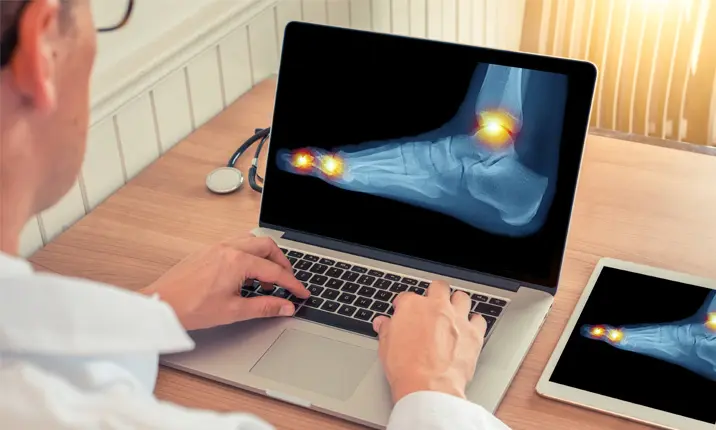-
-
Khu vực chăm sóc và điều trị


Nguồn: Shutterstock
Bạn Có Để Ý Thấy Các Dấu Hiệu Bệnh Gút Này?
Cập nhật lần cuối: 08 Tháng Mười Hai 2022 | 6 phút - Thời gian đọc
Bệnh gút không chỉ là căn bệnh của người giàu. Bác sĩ gia đình Parkway Shenton Tiến Sĩ Wong Pei Ying - chia sẻ chi tiết hơn về các triệu chứng gút, yếu tố rủi ro, các biến chứng tiềm tàng, và cách thức điều trị bệnh.
Bạn có biết rằng gout là dạng phổ biến nhất của tình trạng viêm khớp (viêm khớp do viêm nhiễm)?
Các nghiên cứu vào năm 2012 ước tính rằng tỷ lệ mắc bệnh gout tại Singapore chiếm khoảng 4.1% dân số địa phương. Bệnh thường ảnh hưởng đến nam giới trong độ tuổi 40, nhưng cũng có thể ảnh hưởng đến phụ nữ trong những năm sau tuổi mãn kinh của họ, do mức oestrogen giảm.
Bệnh gút được gây ra bởi sự tích tụ của các tinh thể axit uric trong khớp, gây đau, viêm nhiễm và sưng. Bệnh thường ảnh hưởng đến các khớp chi dưới, chẳng hạn như khớp của một trong các ngón chân cái, nhưng cũng có thể ảnh hưởng đến các khớp khác như các khớp ở bàn chân, mắt cá chân, đầu gối, hay khuỷu tay, và ít phổ biến hơn, các khớp ở các ngón tay và bàn tay.
Nhận Biết Các Triệu Chứng Cơn Gút Nổi Lên
Bạn có thể bị bệnh gout nếu trải qua các triệu chứng tái phát như:
- Đau
- Sưng
- Ban đỏ
- Cứng khớp
Các Yếu Tố Rủi Ro Của Bệnh Gút
Bệnh gút thường được xem là một căn bệnh ảnh hưởng đến các cá nhân thường tiêu thụ một chế độ ăn uống giàu thịt và rượu.
Tuy nhiên, còn có nhiều yếu tố rủi ro đối với bệnh gout. Các yếu tố này bao gồm có tiền sử mắc bệnh gút trong gia đình, dùng một số loại thuốc, và mắc phải các tình trạng bệnh lý khác. Bên cạnh thịt và rượu, các thực phẩm như một số loại hải sản, và việc tiêu thụ đồ uống ngọt và các thực phẩm chứa fructose cũng được liên kết với gia tăng nguy cơ mắc bệnh gout.
Các yếu tố rủi ro của bệnh gout có thể được phân loại thành 2 nhóm chính: các rủi ro có thể thay đổi (bằng cách kiểm soát), và các nhân tố không thể thay đổi (không thể tránh khỏi).
| Các yếu tố rủi ro không thể thay đổi | Các yếu tố rủi ro có thể thay đổi |
|---|---|
| • Giới tính nam • Tăng tuổi • Tiền sử mắc bệnh trong gia đình • Chủng tộc • Gen di truyền • Mãn kinh |
• Chế độ ăn uống • Thuốc • Quản lý các chứng bệnh tiềm ẩn |
Hãy xem xét chi tiết hơn một vài yếu tố rủi ro phổ biến có thể được kiểm soát.
Các Yếu Tố Rủi Ro Về Chế Độ Ăn Uống Đối Với Bệnh Gút
Axit uric được sinh ra khi cơ thể chúng ta phân tách các hợp chất purine. Các bệnh nhân mắc phải bệnh gout nên kiểm soát việc tiêu thụ các loại thực phẩm chứa các mức purine từ trung bình đến cao.
Việc áp dụng một chế độ ăn uống giàu thịt đỏ, hải sản, bia, rượu mạnh, và các đồ uống chứa đường, đặc biệt là những đồ uống có hàm lượng fructose cao, có thể gia tăng nguy cơ mắc bệnh gout.
Các thực phẩm có mức purine rất cao bao gồm:
- Thịt: các bộ phận nội tạng như não, cật và gan, thịt băm, bánh hạch
- Hải sản: cá cơm, cá mòi, cá thu, cá trích, sò, trai
- Men bia và các chất chiết xuất từ thịt
Các thực phẩm có mức purine trung bình bao gồm:
- Thịt: thịt lợn muối, thịt bò, thịt cừu, vịt, ngỗng, thịt cừu non, thịt heo, thịt nai
- Thịt gia cầm: thịt gà
- Hải sản: hàu, cua, cá ngừ, tôm hùm, sò, vẹm, cá hồi, các loại động vật có vỏ khác
- Rau củ: măng tây, bông cải xanh, đậu mắt cua, đậu lăng, đậu lima, nấm, đậu Hà Lan, rau bina
Các Loại Thuốc Và Tình Trạng Bệnh Lý Có Liên Kết Với Bệnh Gút
Một vài loại thuốc như thuốc lợi tiểu, được sử dụng để điều trị cao huyết áp và bệnh tim, có thể gia tăng nguy cơ xuất hiện các triệu chứng bệnh gout.
Các loại thuốc khác có liên kết với gia tăng nguy cơ bị gout bao gồm các loại thuốc kiểm soát huyết áp, chẳng hạn như ACE-inhibitors (thuốc ức chế men chuyển angiotensin), angiotensin-receptor blockers (thuốc ức chế thụ thể angiotensin - ngoại trừ Losartan), và beta-blockers (thuốc chẹn beta).
Các tình trạng bệnh lý có thể dẫn đến bệnh gout bao gồm:
- Bệnh thận mãn tính (CKD)
- Béo phì
- Cao huyết áp
- Mức cholesterol cao
- Suy tim
- Obstructive sleep apnoea (OSA) - chứng ngưng thở khi ngủ do tắc nghẽn
- Psoriasis - bệnh vẩy nến
- Ung thư máu
Chỉ Số Axit Uric Cao Có Phải Là Dấu Hiệu Chắc Chắn Của Bệnh Gout?
Nhiều bệnh nhân có mức axit uric trong máu cao có thể không bao giờ mắc bệnh gout lâm sàng. Việc có chỉ số axit uric trong máu cao cũng liên kết với các tình trạng bệnh khác như hội chứng chuyển hóa, tiểu đường, huyết áp cao, bệnh thận và bệnh tim mạch.
Điều quan trọng là phải xem xét lại các nguyên nhân cùng với bác sĩ của bạn để xác định các yếu tố rủi ro và chủ động thực hiện các bước nhằm giải quyết chúng để giảm thiểu nguy cơ mắc bệnh gout.
Làm Thế Nào Để Kiểm Soát Bệnh Gout Cấp Tính Và Các Cơn Gút Bùng Phát
Bệnh gout cấp tính thông thường xuất hiện dưới dạng sưng và đau đột ngột ở một khớp. Mục đích chính của quá trình điều trị là giảm tình trạng viêm cấp tính.
Trong trường hợp bùng phát cơn gút, bác sĩ thường sẽ khuyên bệnh nhân để khớp được nghỉ ngơi và giới hạn các hoạt động thể chất, cũng như kê đơn một số loại thuốc như thuốc kháng viêm không steroid (NSAID) và colchicine.
Đối với các bệnh nhân không thể dung nạp những loại thuốc này, thuốc steroid có thể được kê đơn để giảm bớt tình trạng viêm. Một vài bệnh nhân có thể yêu cầu sử dụng phương pháp tiêm steroid (tiêm steroid giữa các khớp) để hỗ trợ kiểm soát tình trạng viêm.
Hầu hết thời gian, bệnh gout được chuẩn đoán về mặt lâm sàng, và bác sĩ có thể yêu cầu xét nghiệm máu để kiểm tra chỉ số axit uric. Trong một vài trường hợp, chất dịch có thể được rút ra khỏi khớp bằng kim (chọc hút dịch khớp) để loại trừ các nguyên nhân khác gây sưng khớp.
Dưới đây là một cái nhìn chi tiết hơn về một vài phương pháp điều trị phổ biến cho bệnh gout và tác dụng của chúng:
Thuốc Colchicine
Cách thức tác động: Tác động chống viêm nhiễm, được sử dụng thông dụng trong điều trị bệnh gout và các tình trạng viêm nhiễm khác.
Các tác dụng phụ thông thường: Tiêu chảy, buồn nôn, nôn mửa.
Liều lượng/tần suất sử dụng: Liều thông thường là các viên nang 0.6mg, uống 3 lần mỗi ngày (tùy thuộc vào các tình trạng bệnh lý tiềm ẩn).
Thuốc NSAIDs như các viên nang Ibuprofen, diclofenac, hoặc naproxen
Cách thức tác động: Làm giảm tình trạng viêm nhiễm thông qua việc ức chế một loại enzyme có tên gọi COX (cyclooxygenase).
Các tác dụng phụ thông thường: Khó chịu ở dạ dày. Được sử dụng thận trọng ở các bệnh nhân mắc các chứng bệnh liên quan đến dạ dày, thận, và tim.
Liều lượng/tần suất sử dụng: Uống từ 2 đến 3 lần mỗi ngày.
Thuốc Steroid như các viên nang prednisolone và dexamethasone
Cách thức tác động: Làm giảm tình trạng viêm nhiễm và giảm hoạt động của hệ miễn dịch cơ thể.
Các tác dụng phụ thông thường: Khó chịu dạ dày. Tần suất dùng cao và nhiều có thể gây ra các tác dụng phụ về hệ thống như tăng cân, tăng huyết áp, đường huyết tăng cao, da mỏng dần, và xương yếu đi.
Liều lượng/tần suất sử dụng: Cần được hướng dẫn bởi bác sĩ.
Giảm Thiểu Nguy Cơ Cơn Gút Bùng Phát Và Biến Chứng Của Bệnh Gout Kinh Niên
Trái với niềm tin của nhiều người, các loại thuốc kê đơn hàng ngày bởi bác sĩ an toàn cho việc sử dụng dài hạn và nên được uống đúng theo hướng dẫn. Bệnh gout nếu không được điều trị có thể gây ra nhiều tác hại hơn, đặc biệt là nếu các biến chứng kinh niên dài hạn phát triển, chẳng hạn như sỏi thận và bệnh thận.
Nếu không được điều trị theo thời gian, các cơn gút tái phát có thể trở nên khó kiểm soát hơn. Tình trạng này có thể ảnh hưởng đến nhiều khớp hơn trong cơ thể với thời gian đau và sưng kéo dài hơn. Bệnh thậm chí có thể gây ra tổn thương khớp liên tục.
Bác sĩ sẽ đánh giá các yếu tố rủi ro như độ tuổi của bạn, lượng axit uric trong máu, và các tình trạng bệnh lý khác (như bệnh thận, huyết áp cao, bệnh tim mạch) trước khi đề xuất phương án điều trị.
Loại thuốc được sử dụng phổ biến nhất là thuốc allopurinol, giúp giảm quá trình sản xuất axit uric trong cơ thể. Các loại thuốc khác được dùng trong việc quản lý bệnh gout dài hạn là thuốc febuxostat và thuốc probenecid. Febuxostat cũng tác động bằng cách giảm quá trình sản xuất axit uric trong cơ thể, trong khi probenecid làm tăng sự bài tiết axit uric trong nước tiểu. Dưới sự hướng dẫn của bác sĩ đã được chứng nhận, các loại thuốc này an toàn để sử dụng lâu dài.
Khi mới bắt đầu sử dụng các loại thuốc này, bác sĩ có thể xem xét lại tình trạng sức khỏe của bạn thường xuyên hơn – cứ sau một vài tuần một lần - nhằm kiểm tra xem có khả năng dị ứng hoặc bất kỳ tác dụng phụ nào hay không, và có thể yêu cầu làm xét nghiệm máu để theo dõi tình trạng của bạn.
Chỉ dẫn dành cho việc bắt đầu sử dụng thuốc hàng ngày điều trị bệnh gout (liệu pháp điều trị làm giảm urate) bao gồm:
- Các cơn gout bùng phát tái đi tái lại (từ 2 lần trở lên trong một năm)
- Xuất hiện bất kỳ phần lắng cứng nào của các tinh thể axit uric dưới da (mụn tophi)
- Các dấu hiệu tổn thương khớp do gout, xuất phát từ các cuộc kiểm tra lâm sàng hoặc trên X-quang
- Sỏi thận
Các lựa chọn điều trị khác cho bệnh gout kinh niên bao gồm thuốc pegloticase, hỗ trợ tách nhỏ các axit uric trong cơ thể đến một trạng thái có thể được bài tiết trong nước tiểu. Thuốc có thể được dùng cho các bệnh nhân không thể dung nạp hoặc không có phản ứng với các liệu pháp thông dụng hơn, và được sử dụng trong bối cảnh chăm sóc y tế dưới dạng truyền dịch (infusion medication), uống một lần mỗi 2 tuần. Loại thuốc này không phù hợp với các bệnh nhân mắc chứng thiếu hụt men G6PD.
Nhận trợ giúp và hỗ trợ cho bệnh gút
Nếu bạn nhận thấy bất kỳ triệu chứng nào của bệnh gút hoặc lo lắng về nguy cơ mắc bệnh của mình, hãy truy cập trang web của chúng tôi hoặc trao đổi với bác sĩ đa khoa tại phòng khám y tế Parkway Shenton gần bạn nhất.
Healthier SG là một sáng kiến quốc gia của Bộ Y tế (MOH) nhằm thúc đẩy khả năng tiếp cận và giá cả phải chăng cho dịch vụ chăm sóc phòng ngừa, trao quyền cho người Singapore sống lâu hơn và khỏe mạnh hơn. Các phòng khám Parkway Shenton tự hào là một phần của sáng kiến này. Bằng cách đăng ký với chúng tôi, bạn sẽ tự động trở thành thành viên của chương trình Parkway Plus.
Hãy bắt đầu hành trình Healthier SG của bạn với chúng tôi ngay hôm nay bằng cách sử dụng ứng dụng HealthHub (Xem Câu hỏi thường gặp tại đây). Để được giải đáp thắc mắc hoặc hỗ trợ về việc đăng ký Parkway Plus hoặc Healthier SG, hãy gọi đến đường dây nóng Healthier SG của chúng tôi theo số 6233 9620.
(2017) An Update of the Diagnosis and Management of Gout, Dr Anindita Santosa, The Singapore Family Physician, Vol 4 3(2), April - June 2017
(20 Dec 2019) Appropriate Care Guide, Gout, Achieving the management goal, Agency for Care Effectiveness (ACE), Ministry of Health, Singapore
(2020) John D. FitzGerald, Nicola Dalbeth, Ted Mikuls, Romina Brignardello-Petersen et al, 2020 American College of Rheumatology Guideline for the Management of Gout, ACR Guideline for Management of Gout
(28 Aug 2019) Austin G Stack,corresponding author1 Michelle Elizabeth Johnson,2 Betina Blak,3 Alyssa Klein,4 Lewis Carpenter,2 Robert Morlock,5 Andrew R Maguire,2 and Victoria L Parsons2
BMJ Open, Gout and the risk of advanced chronic kidney disease in the UK health system: a national cohort study. 2019; 9(8): e031550. doi: 10.1136/bmjopen-2019-031550
(Nov 2012) Christopher M. Burns, MD, and Robert L. Wortmann, MD, Latest evidence on gout management: what the clinician needs to know. Ther Adv Chronic Dis. 2012 Nov; 3(6): 271–286. doi: 10.1177/2040622312462056. PMCID: PMC3539261. PMID: 23342241
(26 Aug 2016) Diana I Jalal 1. Hyperuricemia, the kidneys, and the spectrum of associated diseases: a narrative review, Review Curr Med Res Opin. 2016 Nov;32(11):1863-1869. doi: 10.1080/03007995.2016.1218840.
(18 Dec 2014) Isabel Castrejon 1, Esther Toledano, María Piedad Rosario, Estíbaliz Loza, Fernando Pérez-Ruiz, Loreto Carmona. Safety of allopurinol compared with other urate-lowering drugs in patients with gout: a systematic review and meta-analysis, Review Rheumatol Int, 2015 Jul;35(7):1127-37. doi: 10.1007/s00296-014-3189-6.
(28 Aug 2019) Austin G Stack,corresponding author1 Michelle Elizabeth Johnson,2 Betina Blak,3 Alyssa Klein,4 Lewis Carpenter,2 Robert Morlock,5 Andrew R Maguire,2 and Victoria L Parsons2. Gout and the risk of advanced chronic kidney disease in the UK health system: a national cohort study. BMJ Open. 2019; 9(8): e031550. doi: 10.1136/bmjopen-2019-031550
(2017) An Update of the Diagnosis and Management of Gout, Dr Anindita Santosa, The Singapore Family Physician, Vol 4 3(2), April - June 2017
(11 Mar 2002) Hyon K. Choi, M.D., Dr.P.H., Karen Atkinson, M.D., M.P.H., Elizabeth W. Karlson, M.D., Walter Willett, M.D., Dr.P.H., and Gary Curhan, M.D., Sc.D. Purine-Rich Foods, Dairy and Protein Intake, and the Risk of Gout in Men, New England Journal of Medicine
(n.d) Beiwen Wua, Janet M. Roselandb, et al. Availability and quality of published data on the purine content of foods, alcoholic beverages, and dietary supplements, Journal of Food composition and Analysis, 84(2019) 103281
(1 May 2014) K. Kaneko, Y.Aoyagi, +2 authors N. Yamaoka. Total purine and purine base content of common foodstuffs for facilitating nutritional therapy for gout and hyperuricemia, Medicine, Biology, Biological & pharmaceutical bulletin
(20 Dec 2019) Appropriate Care Guide, Gout, Achieving the management goal, Agency for Care Effectiveness (ACE), Ministry of Health, Singapore
(2020) John D. FitzGerald, Nicola Dalbeth, Ted Mikuls, Romina Brignardello-Petersen et al, 2020 American College of Rheumatology Guideline for the Management of Gout, ACR Guideline for Management of Gout
(28 Aug 2019) Austin G Stack,corresponding author1 Michelle Elizabeth Johnson,2 Betina Blak,3 Alyssa Klein,4 Lewis Carpenter,2 Robert Morlock,5 Andrew R Maguire,2 and Victoria L Parsons2
BMJ Open, Gout and the risk of advanced chronic kidney disease in the UK health system: a national cohort study. 2019; 9(8): e031550. doi: 10.1136/bmjopen-2019-031550
(Nov 2012) Christopher M. Burns, MD, and Robert L. Wortmann, MD, Latest evidence on gout management: what the clinician needs to know. Ther Adv Chronic Dis. 2012 Nov; 3(6): 271–286. doi: 10.1177/2040622312462056. PMCID: PMC3539261. PMID: 23342241
(26 Aug 2016) Diana I Jalal 1. Hyperuricemia, the kidneys, and the spectrum of associated diseases: a narrative review, Review Curr Med Res Opin. 2016 Nov;32(11):1863-1869. doi: 10.1080/03007995.2016.1218840.
(18 Dec 2014) Isabel Castrejon 1, Esther Toledano, María Piedad Rosario, Estíbaliz Loza, Fernando Pérez-Ruiz, Loreto Carmona. Safety of allopurinol compared with other urate-lowering drugs in patients with gout: a systematic review and meta-analysis, Review Rheumatol Int, 2015 Jul;35(7):1127-37. doi: 10.1007/s00296-014-3189-6.
(28 Aug 2019) Austin G Stack,corresponding author1 Michelle Elizabeth Johnson,2 Betina Blak,3 Alyssa Klein,4 Lewis Carpenter,2 Robert Morlock,5 Andrew R Maguire,2 and Victoria L Parsons2. Gout and the risk of advanced chronic kidney disease in the UK health system: a national cohort study. BMJ Open. 2019; 9(8): e031550. doi: 10.1136/bmjopen-2019-031550
(2017) An Update of the Diagnosis and Management of Gout, Dr Anindita Santosa, The Singapore Family Physician, Vol 4 3(2), April - June 2017
(11 Mar 2002) Hyon K. Choi, M.D., Dr.P.H., Karen Atkinson, M.D., M.P.H., Elizabeth W. Karlson, M.D., Walter Willett, M.D., Dr.P.H., and Gary Curhan, M.D., Sc.D. Purine-Rich Foods, Dairy and Protein Intake, and the Risk of Gout in Men, New England Journal of Medicine
(n.d) Beiwen Wua, Janet M. Roselandb, et al. Availability and quality of published data on the purine content of foods, alcoholic beverages, and dietary supplements, Journal of Food composition and Analysis, 84(2019) 103281
(1 May 2014) K. Kaneko, Y.Aoyagi, +2 authors N. Yamaoka. Total purine and purine base content of common foodstuffs for facilitating nutritional therapy for gout and hyperuricemia, Medicine, Biology, Biological & pharmaceutical bulletin











